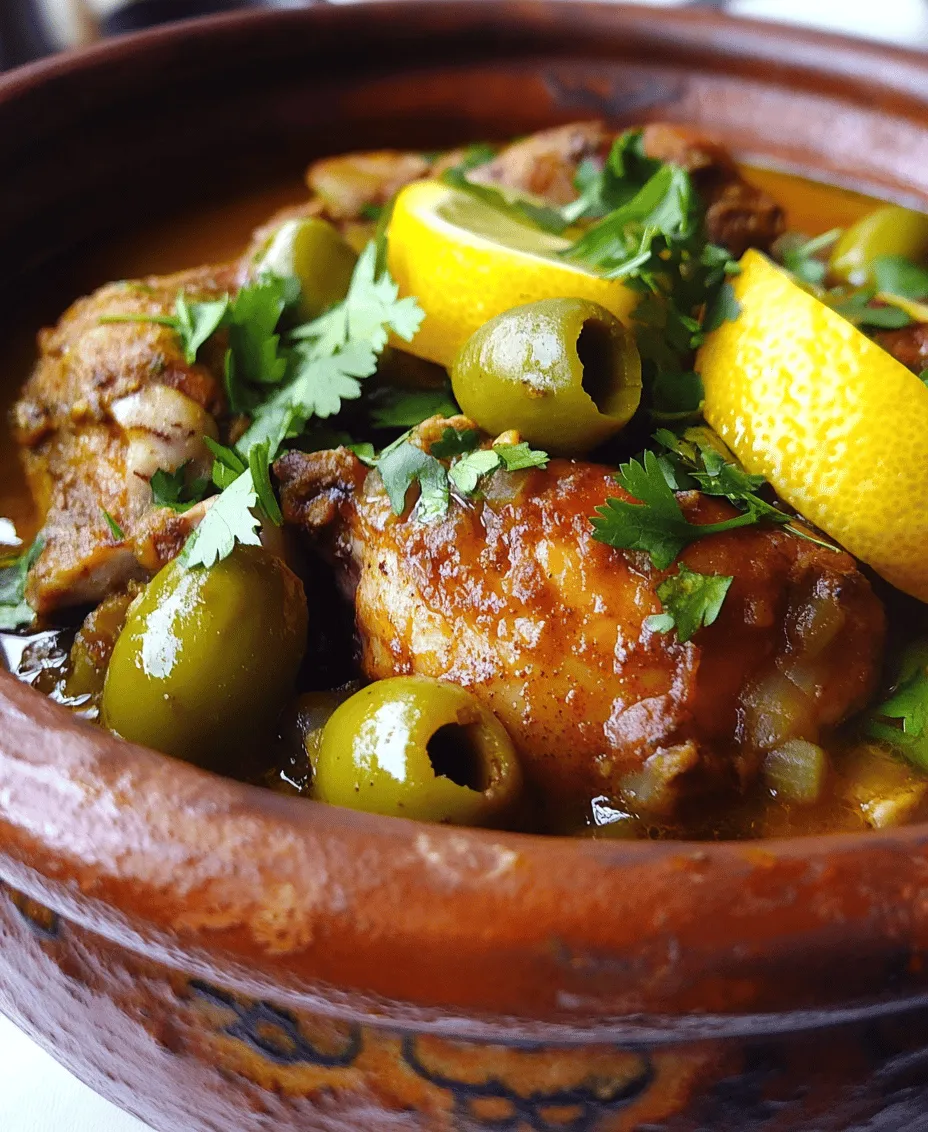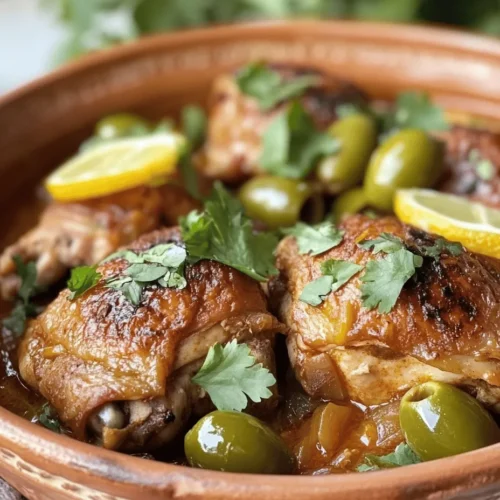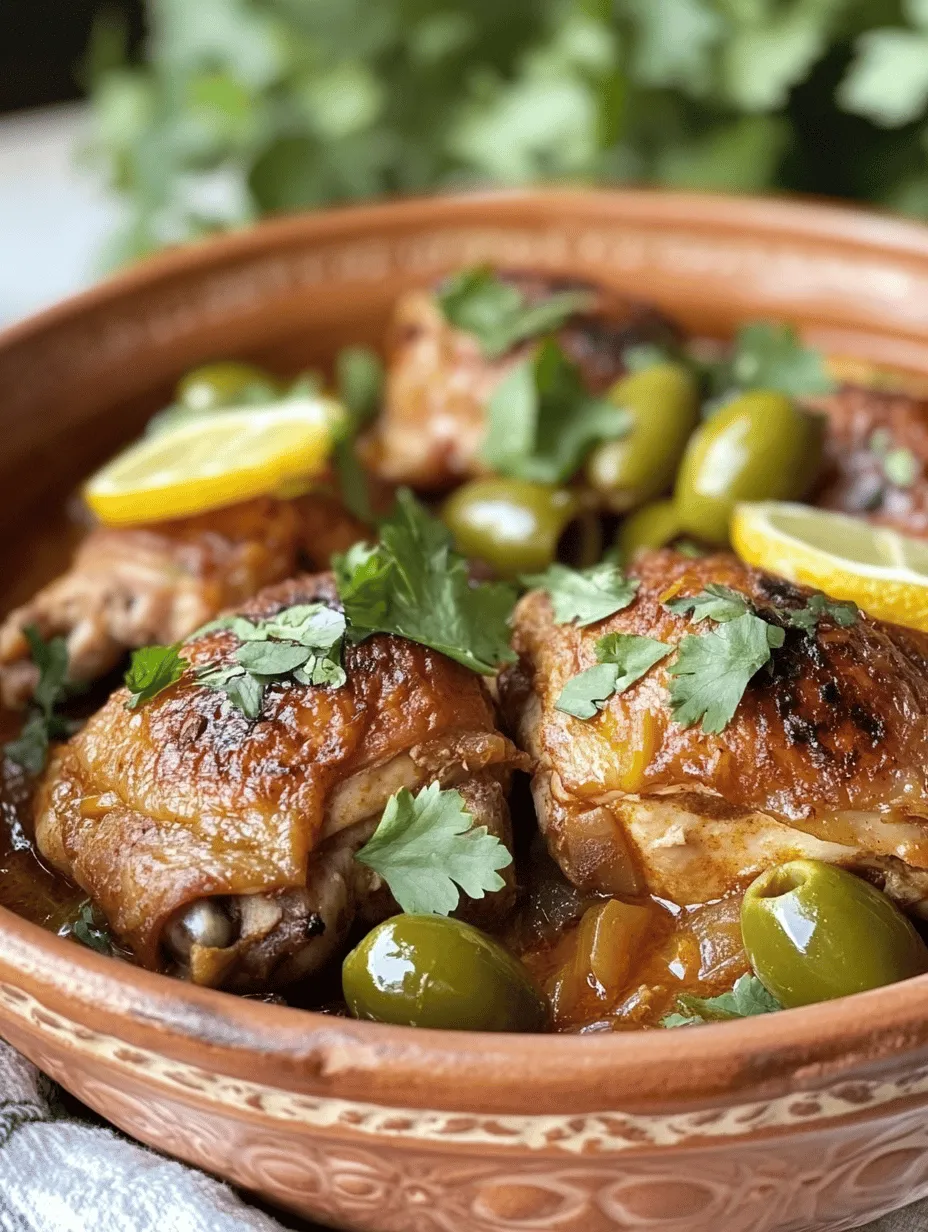Introduction to Moroccan Chicken Tagine with Green Olives and Preserved Lemons
Moroccan cuisine is renowned for its rich tapestry of flavors, colors, and aromas. This North African culinary tradition marries spices, fresh ingredients, and time-honored cooking techniques to create dishes that tantalize the taste buds and nourish the soul. Among the many gems of Moroccan cooking is the iconic chicken tagine—a dish that encapsulates the essence of Moroccan gastronomy.
A tagine, named after the earthenware pot in which it is traditionally cooked, is a slow-cooked stew that blends meat, vegetables, and an array of spices. The unique shape of the tagine pot allows for steam to circulate, ensuring that the ingredients remain moist and tender while infusing each other with flavor. The result is a harmonious dish that reflects the complexity and depth of Moroccan culinary heritage.
This recipe for Moroccan Chicken Tagine with Green Olives and Preserved Lemons showcases the essential components of Moroccan cooking. It highlights the use of succulent chicken thighs, the brininess of green olives, and the zesty brightness of preserved lemons. Together, these ingredients create a dish that is not only delicious but also profound in its cultural significance. As home cooks delve into this recipe, they will not only master the art of tagine cooking but also embark on a flavorful journey through Morocco.
Understanding the Key Ingredients
To create an authentic Moroccan chicken tagine, it’s important to understand the key ingredients that give this dish its distinctive character.
Chicken Thighs
For this recipe, bone-in and skin-on chicken thighs are recommended. This choice is not merely a matter of preference; it serves several purposes. The bone adds depth to the flavor during cooking, while the skin helps retain moisture, resulting in tender, juicy meat. Chicken thighs are also known for their rich flavor compared to chicken breasts, making them a popular choice in tagine dishes. Their ability to absorb spices and aromatics further enhances the overall taste of the stew.
Olive Oil
Olive oil is a staple in Moroccan cuisine, prized for its health benefits and flavor profile. Rich in monounsaturated fats, olive oil is known to support heart health and provide antioxidants. In the context of chicken tagine, it serves as the foundation for sautéing the ingredients and developing the dish’s flavor base. The oil’s fruity notes complement the spices and other ingredients, ensuring a well-rounded flavor experience.
The Spice Spectrum
The magic of Moroccan chicken tagine lies in its spices, which contribute to the dish’s signature warmth and aromatic qualities. Here are the key spices used in this recipe:
– Ground Cumin: Known for its earthy and warm undertones, cumin is a cornerstone of Moroccan spice blends. It adds depth and a slightly nutty flavor that enhances the overall dish.
– Ground Ginger: This spice introduces a hint of warmth and a touch of heat. Its fragrant qualities provide a lively contrast to the other spices, creating a balanced flavor profile.
– Ground Cinnamon: Often associated with sweet dishes, cinnamon also plays a crucial role in savory Moroccan dishes. Its sweet and aromatic notes add complexity to the tagine, making each bite a delightful experience.
– Turmeric: Beyond its vibrant golden color, turmeric offers numerous health benefits, including anti-inflammatory properties. Its earthy flavor complements the other spices beautifully, contributing to the overall flavor of the dish.
– Cayenne Pepper: For those who enjoy a bit of heat, cayenne pepper can be adjusted according to personal preference. A pinch adds a subtle kick that enhances the flavor without overpowering the dish.
Green Olives
Green olives are a quintessential element in Moroccan cooking. Their briny flavor and firm texture provide a delightful contrast to the tender chicken and the sweetness of the spices. Additionally, olives are rich in healthy fats and antioxidants, making them a nutritious addition to the tagine. The olives can be added whole or sliced, depending on your preference, and their flavor intensifies as they simmer in the stew.
Preserved Lemons
One of the most distinctive ingredients in Moroccan cuisine, preserved lemons are a game-changer in this tagine recipe. The lemons undergo a fermentation process that transforms their sharp acidity into a mellow, tangy flavor. This unique ingredient adds brightness and depth to the dish, enhancing the overall flavor profile. The rind is often used, imparting a complex citrusy note that balances the richness of the chicken and the saltiness of the olives.
Optional Ingredients
For those looking to add an extra layer of sweetness to the dish, consider incorporating dried apricots and a drizzle of honey. The dried apricots, when rehydrated during cooking, provide a subtle sweetness that complements the savory elements of the tagine. A touch of honey can also enhance the overall flavor, creating a delightful contrast to the tartness of the preserved lemons and olives.
Cooking Equipment Essentials
To prepare Moroccan chicken tagine, having the right equipment is essential for an authentic cooking experience.
Traditional Tagine vs. Dutch Oven
While a traditional tagine pot is ideal for cooking this dish, a Dutch oven serves as an excellent alternative. Both vessels are designed for slow cooking, allowing flavors to meld beautifully. The tagine pot, with its conical lid, is specifically designed for steam circulation, which results in tender, juicy meat. However, a heavy-duty Dutch oven will also do the job effectively, making it accessible for those who may not have a tagine on hand.
Other Necessary Kitchen Tools
In addition to the cooking vessel, a few essential kitchen tools will make the preparation process smoother:
– Knife: A sharp knife is crucial for chopping vegetables and cutting chicken.
– Cutting Board: A sturdy cutting board provides a safe space for chopping and preparing your ingredients.
– Measuring Spoons: For precise measurements of spices, having a set of measuring spoons ensures that the flavors are balanced.
– Serving Dishes: Once the tagine is cooked, it can be served directly from the tagine pot or transferred to a beautiful serving dish for presentation.
Importance of Proper Equipment
Using the right equipment not only enhances the cooking process but also contributes to the authenticity of the dish. The traditional tagine pot, with its unique design, allows for a cooking method that is both efficient and flavorful. If you opt for a Dutch oven, choose one that is heavy and retains heat well to create a similar cooking environment.
Step-by-Step Guide to Making Moroccan Chicken Tagine
Now that you’re familiar with the key ingredients and essential equipment, let’s dive into the preparation of Moroccan Chicken Tagine. Below are the detailed steps to get you started on this flavorful culinary adventure.
Detailed Preparation of Ingredients
Before embarking on the cooking process, it’s crucial to prepare your ingredients. Here’s how to do it:
1. Chop the Vegetables: Begin by finely chopping any aromatic vegetables you plan to include, such as onions and garlic. These will form the base of your tagine.
2. Measure the Spices: Take the time to measure out each spice accurately. Having them pre-measured will streamline your cooking process and help you maintain the right flavor balance.
3. Marinate the Chicken (Optional): If you have time, consider marinating the chicken thighs in a mixture of olive oil, spices, and lemon juice for at least an hour or overnight. This step allows the flavors to penetrate the meat, resulting in a more flavorful dish.
Step 1: Heating the Olive Oil and Browning the Chicken
With your ingredients prepared, it’s time to begin the cooking process:
– Heat the Olive Oil: In your tagine pot or Dutch oven, heat a generous amount of olive oil over medium-high heat. Allow it to warm until it shimmers.
– Brown the Chicken: Carefully add the chicken thighs to the pot, skin-side down. Ensure that the pieces are not overcrowded, as this will prevent proper browning. Sear the chicken for about 4-5 minutes on each side until it develops a golden-brown crust. This step is crucial as it enhances the flavor of the dish by creating a caramelized exterior.
Browning the chicken not only adds depth of flavor but also locks in moisture, ensuring that the meat remains juicy throughout the cooking process. Once the chicken is beautifully browned, remove it from the pot and set it aside while you prepare the aromatic base for the tagine.
As you immerse yourself in this cooking adventure, remember that each step holds significance in building the flavors that will culminate in a delightful Moroccan Chicken Tagine with Green Olives and Preserved Lemons. This dish invites you to explore the vibrant world of Moroccan cuisine and share its rich flavors with family and friends.

Step 2: Sautéing Onions and Garlic
Sautéing onions and garlic is a critical step in crafting the perfect Moroccan chicken tagine. To achieve the ideal texture and aroma, start by heating a generous amount of olive oil in your tagine or a heavy-bottomed pot over medium heat. Once the oil shimmers, add finely chopped onions and cook them until they become translucent, stirring occasionally to prevent burning. This process usually takes about 5-7 minutes.
Adding minced garlic toward the end of the onion sautéing process is essential. Garlic cooks faster and can burn easily, which results in a bitter flavor. Incorporating it when the onions are nearly done allows the garlic to release its aromatic oils without overcooking. Stir frequently for another 1-2 minutes until fragrant, creating a flavorful foundation for your tagine.
Step 3: Incorporating Spices
The magic of Moroccan cuisine lies in its vibrant spices. After your onions and garlic are beautifully sautéed, it’s time to add the spices. Use a combination of ground cumin, coriander, ginger, cinnamon, turmeric, and pepper to create a warm and aromatic blend.
Timing is crucial when incorporating spices. Sprinkle them over the onion and garlic mixture and sauté for about 1-2 minutes, stirring constantly. This technique, known as blooming, helps to release the essential oils and flavors locked within the spices, setting the stage for a rich and layered flavor profile in your dish.
Step 4: Simmering the Chicken
Now that your base is aromatic and full of flavor, it’s time to add the chicken. Arrange the chicken pieces skin-side down in the pot, allowing them to sear slightly before flipping them over. This step not only enhances the flavor but also creates a beautiful golden color on the chicken.
Once the chicken has a nice sear, add chicken broth or water until the chicken is just submerged. This is vital for even cooking, ensuring that every piece of chicken absorbs the flavors of the spices and aromatics. Bring the mixture to a gentle simmer, then reduce the heat to low, cover, and let it cook slowly. This slow cooking method allows the chicken to become tender and juicy, soaking in all the flavors from the spices and vegetables.
Step 5: Adding Olives and Preserved Lemons
About 20 minutes before the chicken is fully cooked, it’s time to introduce the olives and preserved lemons. The briny flavor of green olives combined with the citrusy zing of preserved lemons is quintessential to Moroccan tagine, providing an authentic taste that balances the savory notes of the chicken.
To prepare, rinse the preserved lemons to remove excess salt, then slice them into quarters, removing any seeds. Add both the olives and lemons to the pot, stirring gently to combine them with the chicken and sauce. Allow them to simmer together, which helps meld the flavors further and enhances the complexity of the dish.
Step 6: Cooking Time and Monitoring Sauce Consistency
The cooking time for Moroccan chicken tagine typically ranges from 60 to 90 minutes, depending on the size of your chicken pieces and the heat level. It’s crucial to monitor the sauce’s consistency as it simmers. You want a sauce that is thick enough to coat the chicken but not too dry.
If you find that the sauce is reducing too quickly, you can add a bit more broth or water. Conversely, if the sauce is too watery, you can remove the lid for the last part of cooking to allow some of the liquid to evaporate. The goal is to achieve a rich, flavorful sauce that complements the tender chicken.
Step 7: Optional Honey Addition
For those who enjoy the sweet and savory combination that Moroccan cuisine is known for, consider adding a tablespoon or two of honey toward the end of the cooking process. This optional step can enhance the overall flavor of the dish, balancing the savory spices and the acidity of the preserved lemons. Stir the honey into the sauce and let it simmer for an additional 5 minutes, allowing the flavors to meld beautifully.
Step 8: Serving Suggestions
Moroccan chicken tagine is best served with traditional accompaniments. Pair it with fluffy couscous or steamed rice to soak up the delicious sauce. To elevate your meal, consider garnishing the tagine with fresh cilantro or parsley, adding a pop of color and freshness.
For a complete experience, serve warm, crusty bread on the side for dipping into the savory sauce. Additionally, a side of a simple salad, made with fresh vegetables and a light vinaigrette, can provide a refreshing contrast to the rich flavors of the tagine.
Exploring Flavor Profiles and Variations
The balance of flavors in Moroccan chicken tagine showcases the harmony of sweet, savory, and spicy elements. The carefully selected spices create a depth of flavor that is distinctively Moroccan.
Possible Variations on the Recipe
1. Different Vegetables or Fruits: Feel free to customize your tagine by adding seasonal vegetables like carrots, zucchini, or bell peppers. Dried fruits such as apricots or raisins can also be included for a delightful sweetness.
2. Adjusting Spice Levels: For those who prefer milder dishes, reduce the amount of spices or use mild paprika instead of cayenne pepper. Conversely, for a spicier kick, add a pinch of red pepper flakes or more ginger.
3. Pairing with Sides and Drinks: To elevate your meal, pair the tagine with a light white wine such as a Sauvignon Blanc or a refreshing mint tea, which complements the dish’s flavors beautifully.
Cultural Significance of Tagine Cooking
Cooking with a tagine is more than just a method; it is a cherished tradition in Moroccan culture. The tagine pot, typically made from clay, is designed to slow-cook food, allowing the flavors to meld and intensify. This communal cooking method invites family and friends to gather around the table, sharing not just a meal but also stories and laughter, embodying the essence of Moroccan hospitality.
In Moroccan culture, the act of sharing a tagine brings people together, fostering a sense of community and connection. The dish represents the warmth and generosity of Moroccan culinary traditions, making it a staple in many households.
Nutritional Information
When it comes to nutrition, Moroccan chicken tagine is a well-rounded meal that provides a variety of essential nutrients. A typical serving contains approximately:
– Calories: 350-400
– Protein: 30g
– Carbohydrates: 20g
– Fats: 15g
The main ingredients offer numerous health benefits. Chicken provides a great source of lean protein, while olives offer healthy fats, antioxidants, and vitamin E. Preserved lemons contribute vitamin C and aid in digestion, making this dish not only delicious but also nutritious.
For those with dietary considerations, this recipe can easily be adapted. It is naturally gluten-free, and with the right modifications, can fit into paleo and low-carb diets. Simply serve it without couscous or rice for a lighter option.
Conclusion: The Delight of Homemade Moroccan Chicken Tagine
In conclusion, Moroccan chicken tagine with green olives and preserved lemons is a delightful dish that captures the essence of Moroccan cuisine. Its rich flavors, aromatic spices, and cultural significance make it a standout meal that is sure to impress.
As you explore the world of Moroccan cooking, remember the joy of preparing and sharing this dish with loved ones. The warmth of communal dining, combined with the complexity of flavors, makes this tagine a perfect addition to any dinner table. So, roll up your sleeves, gather your ingredients, and embark on a culinary adventure that celebrates the vibrant traditions of Morocco.



